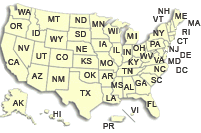Review of selected features of the Natural System Model, and
suggestions for applications in South Florida
Water-Resources Investigations Report 97-4039
By J.D. Bales, J.M. Fulford, and Eric Swain
Abstract
A study was conducted to review selected features of the Natural System Model, version 4.3. The Natural System Model is a regional-scale model that uses recent climatic data and estimates of historic vegetation and topography to simulate pre-canal-drainage hydrologic response in south Florida. Equations used to represent the hydrologic system and the numerical solution of these equations in the model were documented and reviewed. Convergence testing was performed using 1965 input data, and selected other aspects of the model were evaluated.
Review of the computer code indicated that there is no limit on the amount of water that can be transferred from the river system to the overland-flow system, on the amount of seepage from the river to the ground-water system, on evaporation from the river system, or on evapotranspiration from the overland-flow system. Oscillations of 0.2 foot or less in simulated river stage were identified, and attributed to a volume limiting function which is applied in solution of the overland-flow equations. The computation of the resistance coefficient is not consistent with the computation of overland-flow velocity. Ground-water boundary conditions do not always ensure a no-flow condition at the boundary. These inconsistencies had varying degrees of effects on model simulations, and it is likely that simulations longer than 1 year are needed to fully identify effects. However, inconsistencies in model formulations should not be ignored, even if the effects of such errors on model results appear to be small or have not been clearly defined.
The Natural System Model can be a very
useful tool for estimating pre-drainage hydrologic
response in south Florida. The model includes all
of the important physical processes needed to
simulate a water balance. With a few exceptions,
these hydrologic processes are represented in a
reasonable manner using empirical, semi-
empirical, and mechanistic relations. The data sets
that have been assembled to represent physical
features, and hydrologic and meteorological
conditions are quite extensive in their scope.
Some suggestions for model application
were made. Simulation results from the Natural
System Model need to be interpreted on a regional
basis, rather than cell by cell. The available
evidence suggests that simulated water levels
probably should be reported to the nearest foot. It
is probably not appropriate to use the Natural
System Model to estimate pre-drainage flows, and
all simulated results for computational cells within
about 10 miles of the model boundaries have a
higher degree of uncertainty than results for the
interior of the model domain. It is most
appropriate to interpret the Natural System Model
simulation results in connection with other
available information. Stronger linkages between
hydrologic inputs to the Everglades and the
ecological response of the system would enhance
restoration efforts.
Citation:
Bales, J.D., Fulford, J.M., and Swain, Eric, 1997, Review of selected features of the Natural System Model, and suggestions for applications in South Florida: U.S. Geological Survey Water-Resources Investigations Report 97-4039, 42 p.
|
For more information, contact |
To order printed copies, contact |
North Carolina Water Science Center
U.S. Geological Survey
3916 Sunset Ridge Road
Raleigh, North Carolina 27607
(919) 571-4000
E-mail
|
U.S. Geological Survey
Information Services
Box 25286, Federal Center
Denver, CO 80225
1-888-ASK USGS
|
|
